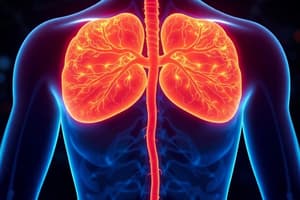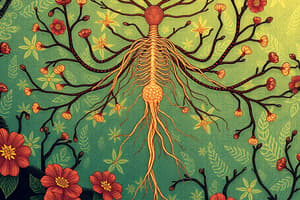Podcast
Questions and Answers
Which of the following receptors are responsible for mediating the effects of acetylcholine in the sympathetic ganglia?
Which of the following receptors are responsible for mediating the effects of acetylcholine in the sympathetic ganglia?
- Alpha-1 receptors
- Nicotinic receptors (correct)
- Muscarinic receptors
- Beta-2 receptors
Which of the following substances acts as an antagonist to muscarinic receptors?
Which of the following substances acts as an antagonist to muscarinic receptors?
- Hexamethonium
- Atropine (correct)
- Nicotine
- Tubocurarine
What is the primary mode of action for nicotinic receptors?
What is the primary mode of action for nicotinic receptors?
- Ligand-gated ion channel activation (correct)
- Second messenger cascades
- Direct activation of adenylate cyclase
- G-protein coupled signaling
Which of the following is NOT a characteristic of the parasympathetic nervous system?
Which of the following is NOT a characteristic of the parasympathetic nervous system?
Which of the following correctly describes the effect of activating Beta-1 receptors?
Which of the following correctly describes the effect of activating Beta-1 receptors?
Which of the following subtypes of nicotinic receptors is located at the neuromuscular junction?
Which of the following subtypes of nicotinic receptors is located at the neuromuscular junction?
Which neurotransmitter(s) are involved in adrenergic transmission?
Which neurotransmitter(s) are involved in adrenergic transmission?
What is the primary mechanism by which muscarinic receptors mediate their effects?
What is the primary mechanism by which muscarinic receptors mediate their effects?
Which of the following is NOT a symptom of Horner syndrome?
Which of the following is NOT a symptom of Horner syndrome?
What is the primary function of the enzyme acetylcholine esterase (AChE)?
What is the primary function of the enzyme acetylcholine esterase (AChE)?
Which of the following accurately describes the effects of activating Alpha-1 receptors?
Which of the following accurately describes the effects of activating Alpha-1 receptors?
Where are the majority of sympathetic postganglionic neurons located?
Where are the majority of sympathetic postganglionic neurons located?
Which of the following drugs would be most effective in blocking the effects of acetylcholine at the neuromuscular junction?
Which of the following drugs would be most effective in blocking the effects of acetylcholine at the neuromuscular junction?
Which enzyme is involved in the breakdown of norepinephrine in the nerve endings?
Which enzyme is involved in the breakdown of norepinephrine in the nerve endings?
Which of the following is TRUE about the synthesis of epinephrine and norepinephrine?
Which of the following is TRUE about the synthesis of epinephrine and norepinephrine?
What is the role of sympathetic postganglionic neurons that innervate sweat glands?
What is the role of sympathetic postganglionic neurons that innervate sweat glands?
Flashcards
Parasympathetic Nervous System (PNS)
Parasympathetic Nervous System (PNS)
Part of the autonomic nervous system that dominates under normal conditions, promoting digestion and rest.
Sympathetic Nervous System (SNS)
Sympathetic Nervous System (SNS)
Part of the autonomic nervous system that prepares the body for stress, enabling fight or flight responses.
Horner Syndrome
Horner Syndrome
A rare disorder from disrupted sympathetic innervation, characterized by anhidrosis, ptosis, and miosis.
Cholinergic Transmission
Cholinergic Transmission
Signup and view all the flashcards
Adrenergic Transmission
Adrenergic Transmission
Signup and view all the flashcards
ACh Synthesis
ACh Synthesis
Signup and view all the flashcards
NE Synthesis
NE Synthesis
Signup and view all the flashcards
ACh Degradation
ACh Degradation
Signup and view all the flashcards
Cholinergic Receptors
Cholinergic Receptors
Signup and view all the flashcards
Nicotinic Receptors
Nicotinic Receptors
Signup and view all the flashcards
Muscarinic Receptors
Muscarinic Receptors
Signup and view all the flashcards
Alpha Receptors
Alpha Receptors
Signup and view all the flashcards
Beta Receptors
Beta Receptors
Signup and view all the flashcards
M1 Receptor Function
M1 Receptor Function
Signup and view all the flashcards
B1 Receptor Function
B1 Receptor Function
Signup and view all the flashcards
B2 Receptor Function
B2 Receptor Function
Signup and view all the flashcards
Study Notes
Autonomic Nervous System II
- Objectives:
- Compare parasympathetic and sympathetic nervous system functions.
- Identify neurotransmitters and receptor types involved in autonomic nervous system neurotransmission and target organs.
Functions of the Parasympathetic Nervous System (PNS)
- Dominates during normal physiological conditions.
- Primary function: "Rest and Digest".
- Note: The parasympathetic system is always active in the gastrointestinal (GIT) and urinary systems.
Functions of the Sympathetic Nervous System (SNS)
- Prepares the organism to handle environmental stresses.
- Primary function: "Fight or Flight".
Parasympathetic and Sympathetic Divisions
- Diagram (Page 5): Shows the pathways (cranial, thoracic, lumbar, sacral nerves) for each system, illustrating the effects on different organs (eg., pupils, heart, breathing, digestion, etc.). Sympathetic division increases activity during stress, while parasympathetic division works to return the body to a resting state.
Horner Syndrome
- Rare disorder caused by interruption of preganglionic/postganglionic sympathetic innervation to the face.
- Possible causes include injury to nerves, carotid artery injury, stroke, brain stem lesions, or tumors.
- Typically unilateral (one side).
- Hallmark triad:
- Anhidrosis (reduced sweating).
- Ptosis (drooping eyelid).
- Miosis (constricted pupil).
- Additional symptoms may include: Enophthalmos (sunken eyeball), and vasodilation.
Chemical Transmission at Autonomic Junctions
- Cholinergic transmission: Primarily uses Acetylcholine (ACh).
- Adrenergic transmission: Primarily uses Epinephrine (E) / adrenaline, and Norepinephrine (NE) / noradrenaline.
Cholinergic Autonomic Neurons
- All preganglionic neurons release ACh.
- All parasympathetic postganglionic neurons release ACh.
- Some sympathetic postganglionic neurons release ACh (e.g., sweat glands, some blood vessels).
Adrenergic Neurons
- Most sympathetic postganglionic neurons release norepinephrine (NE).
- Exceptions: Sweat glands and some blood vessels.
- Adrenal glands.
ACh Synthesis and Degradation
- ACh is synthesized from acetyl CoA and choline.
- Stored in vesicles in nerve endings.
- After action, ACh is broken down by acetylcholinesterase (AChE).
- Choline is recycled.
- Some ACh diffuses away into the surrounding fluids, where pseudocholinesterase breaks it down.
NE Synthesis and Degradation
- NE is synthesized from tyrosine, dopamine, and norepinephrine.
- Stored in synaptic vesicles.
- After action, NE is broken down by monoamine oxidase (MAO) in nerve endings, and catechol-O-methyltransferase (COMT) in other tissues.
Autonomic Receptors
- Cholinergic:
- Muscarinic
- Nicotinic
- Adrenergic:
- Alpha
- Beta
Nicotinic Receptors
- Respond to ACh and nicotine.
- Do not respond to muscarine.
- Act through ligand-gated ion channels.
- Blocked by tubocurarine (neuromuscular blocker).
- Activation results in rapid increases in sodium (Na+) and calcium (Ca2+) conductance, depolarization, and excitation.
- Two subtypes:
- Nm (neuromuscular end plate, skeletal muscle)
- Nn (autonomic ganglia).
Muscarinic Receptors
- Respond to ACh, muscarine, and carbachol.
- Blocked by atropine.
- Coupled via G-proteins, activating second messengers (e.g., cAMP).
- Multiple subtypes (M1, M2, M3).
Adrenergic Receptors (Alpha and Beta)
-
Alpha 1, Alpha 2 (located in various tissues).
-
Beta 1, Beta 2, Beta 3 (located in various tissues).
-
Different subtypes have different effects (e.g., on heart rate, blood vessels, etc.)
-
Detailed receptor locations and effects of binding on various tissues (Page 21)
Studying That Suits You
Use AI to generate personalized quizzes and flashcards to suit your learning preferences.




